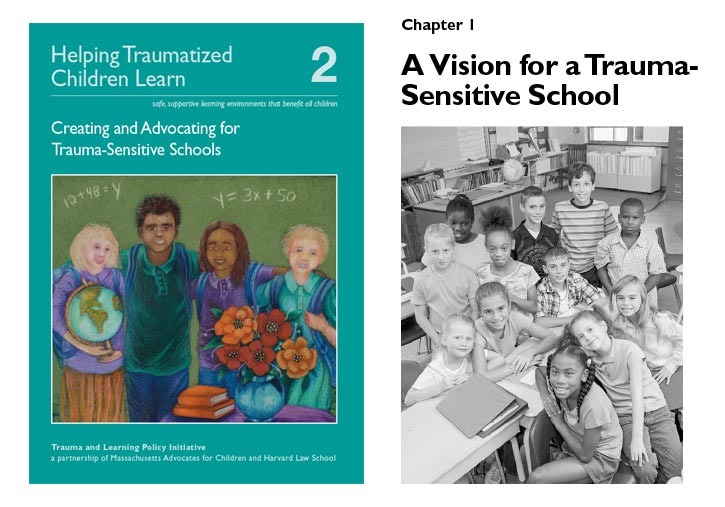Part 1: What is a Trauma-Sensitive School?
A trauma-sensitive school is one in which all students feel safe, welcomed, supported, and empowered to participate fully in all the school has to offer. It is a school where addressing trauma’s impacts on learning, including trauma from racism and other structural inequities, on a school-wide basis is at the center of its educational mission. It is a place where an on-going, inquiry-based process allows for the necessary teamwork, coordination, creativity, and sharing of responsibility for all students, and where continuous learning is for educators as well as students.
There is no one-size-fits-all approach to creating a trauma-sensitive school. However, based on our work with schools, we have identified six core attributes that trauma-sensitive schools have in common. Taken together, these attributes can be thought of as a trauma-sensitive vision to which any school can aspire.
Learn more about each of the 6 attributes through reading these blog posts:
1. Leadership and Staff Share a School-Wide Approach
The first attribute of a trauma-sensitive school is that leadership and staff share an understanding of trauma’s impacts on learning and the need for a school-wide approach. Read more…
2. Supporting All Children to Feel Safe
The second common attribute of a trauma-sensitive school is that the school supports all students to feel safe-physically, socially, emotionally, and academically.
Read more…
3. A Trauma-Sensitive School Addresses Students’ Needs in Holistic Ways
The impacts of traumatic experiences can take many forms, and a traumatized student’s behavior can mask, rather than reveal, their difficulties. Read more…
4. Trauma-Sensitive Schools Explicitly Connect Students to the School Community
A trauma-sensitive school connects students to the school community and provides opportunities for students to practice new skills. Read more…
5. Trauma-Sensitive Schools Embrace Teamwork and Share Responsibility for All Students
The school embraces teamwork and staff share responsibility for all students. Read more…
6. Leadership and Staff Anticipate and Adapt to the Ever-Changing Needs of Students
Educators and administrators in a trauma sensitive school do their best to adapt to challenges flexibly and proactively so that the equilibrium of the school is maintained despite inevitable shifts and changes. Read more…
Take a deeper dive:
 Read Chapter 1 of Helping Traumatized Children Learn, Vol 2 for more information about the attributes of a trauma-sensitive school.
Read Chapter 1 of Helping Traumatized Children Learn, Vol 2 for more information about the attributes of a trauma-sensitive school.
EXCERPT (Chapter 1):
Each school will implement trauma sensitivity in its own unique way. However, a shared definition of what it means to be trauma-sensitive can bring educators, parents, and policymakers together around a common vision that can help them meet ongoing challenges. A trauma-sensitive school is one in which all students feel safe, welcomed, and supported and where addressing trauma’s impact on learning on a school-wide basis is at the center of its educational mission. It is a place where an ongoing, inquiry-based process allows for the necessary teamwork, coordination, creativity, and sharing of responsibility for all students, and where continuous learning is for educators as well as students.
No single attribute of a trauma-sensitive school can be viewed as an isolated fragment; they are all interrelated, adding up to a whole that is greater than the sum of its parts. Together they define ways to empower schools to understand and realize a shared vision.
For schools to achieve trauma sensitivity, it is important to clarify this vision to show what trauma-sensitive ways of responding to students can look like at school. Based on our past eight years of work in schools, and with the input of our partners, we have distilled six distinct but interrelated attributes of a trauma-sensitive school that are described in the first section of this chapter. A set of questions based on these attributes serves as a tool to help keep the vision of trauma sensitivity in the foreground as educators carry out the multiple daily demands of the modern education system. The attributes and associated questions help schools evaluate which efforts will lead the school toward the trauma-sensitive vision. Ultimately they help the school identify which efforts are successful, and which need more work, as they pursue the kind of change they are seeking. Read more…
Part 3: Visions of a Trauma-Sensitive School Questions
Question 1: Why do we feel an urgency to become a trauma-sensitive school?
Question 2: How do we know we are ready to create a Trauma-Sensitive Action Plan?
Question 3: What actions will address staff priorities and help us become a Trauma-Sensitive School?
Question 4: How do we know we are becoming a Trauma-Sensitive School?





